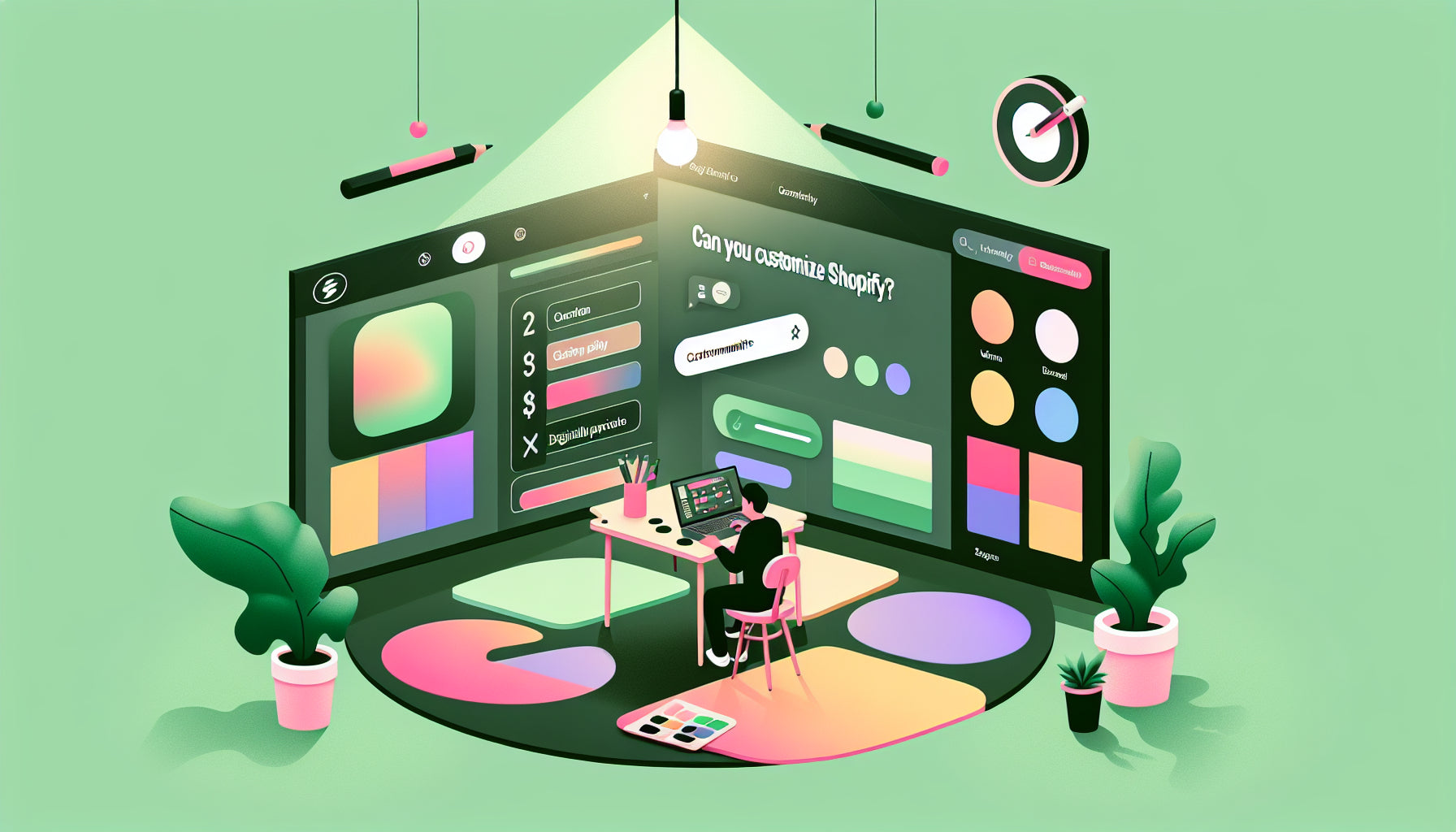Can You Customize Shopify?

Table of Contents
- Introduction
- Shopify Themes: The Foundation of Customization
- Utilizing Shopify Apps
- Advanced Customization Techniques
- Maintaining a Consistent Brand Identity
- Conclusion
- FAQs
Introduction
In the bustling world of e-commerce, standing out from your competitors is crucial. But how can you make your Shopify store unique? The answer lies in customization. Whether you're a seasoned developer or a newbie, customizing your Shopify store can seem daunting, but it's an essential part of creating a distinctive and powerful online presence.
Can you customize Shopify? Absolutely! From modifying themes and tweaking settings to adding custom code and utilizing apps, Shopify offers a plethora of customization options. This blog post aims to guide you through the ins and outs of Shopify customization, ensuring your store reflects your brand's unique identity.
By the end of this article, you'll understand the various aspects of Shopify customization, including themes, settings, apps, and advanced coding options. We'll explore the tools and techniques you can use to make your Shopify store look and feel exactly how you want. So, whether you're a DIY enthusiast or considering hiring a professional, this guide has got you covered.
Shopify Themes: The Foundation of Customization
Choosing the Right Theme
The first step in customizing your Shopify store is selecting the right theme. Shopify offers a variety of free and paid themes in its Theme Store. These themes are designed to be mobile-friendly and optimized for performance, but they also come with different levels of customization:
- Free Themes: Simple and versatile, free themes are great for beginners. They provide essential features and a clean slate for customization.
- Paid Themes: These come with advanced functionalities and design elements. If your budget allows, a paid theme can offer a more polished look and additional custom options.
Before you settle on a theme, consider your brand’s aesthetic, the type of products you sell, and the functionalities you need. Test different themes to see which one best fits your vision.
Using the Theme Editor
Once you've chosen a theme, the Shopify Theme Editor allows you to tailor it to your liking without touching a line of code. To access the Theme Editor:
- Navigate to your Shopify admin.
- Go to Online Store > Themes.
- Click Customize next to the theme you wish to edit.
The editor provides a preview of your store along with various customization options including colors, fonts, product images, and layout sections. This WYSIWYG (What You See Is What You Get) interface makes it easy to see changes in real-time.
Key Areas for Theme Customization
- Homepage Sections: Customize different sections like sliders, featured collections, and testimonials.
- Typography: Choose fonts that align with your brand’s identity. Sticking to a couple of font families can maintain consistency.
- Color Scheme: Use your brand colors to enhance recognition and aesthetic appeal.
- Header and Footer: Modify these to include your logo, navigation menu, and social media links.
Advanced Theme Customization
For more granular control, you might need to delve into the theme’s code. Shopify themes are built using Liquid, a templating language that allows dynamic content.
Editing the Theme Code
Access the code editor by navigating to Online Store > Themes > Actions > Edit Code. Here, you can modify HTML, CSS, and Liquid files. It’s advisable to duplicate your theme before making any changes, ensuring you have a backup if something goes wrong.
Some common customizations include:
- Adding Custom Scripts: Enhance functionalities with JavaScript.
- Modifying Theme Structure: Change the layout by editing Liquid files.
- Custom CSS: Alter the look and feel by adding your own styles.
Hiring a Shopify Expert
If coding isn’t your forte, consider hiring a Shopify Expert. Shopify’s Experts Marketplace connects you with professionals who can customize your store according to your specifications.
Utilizing Shopify Apps
Shopify’s App Store is a treasure trove of extensions that can add functionalities without manual coding. Whether you need to enhance your site's SEO, integrate social media, or add new payment gateways, there's likely an app for that.
Popular Customization Apps
- Shogun Page Builder: A drag-and-drop builder that lets you create custom landing pages.
- Yotpo Reviews: Add customer review sections to build trust.
- Oberlo: Simplify dropshipping with this powerful tool.
- Privy: Improve your email marketing with pop-ups and banners.
Installing and Configuring Apps
Installing an app is straightforward:
- Visit the Shopify App Store.
- Search for the app you need.
- Click Add app, then follow the setup instructions.
Most apps come with detailed guides and customer support, making the setup process a breeze.
Advanced Customization Techniques
For those who want to push the boundaries of what Shopify can do, advanced customization options are available. These require more technical expertise but offer unparalleled control over your store’s functionality.
Using Shopify Scripts
Available to Shopify Plus users, Shopify Scripts allow you to create personalized shopping experiences. Scripts can manipulate line items, shipping methods, and payment gateways based on the customer’s cart content or location.
Creating Custom Apps
If existing apps don’t meet your needs, consider creating a custom app. Use Shopify's APIs to build robust integrations that enhance your store’s functionality. This approach is ideal for large businesses with unique requirements.
Maintaining a Consistent Brand Identity
Consistent branding is key to maintaining customer trust and recognition. When customizing your Shopify store, keep your brand guidelines handy. Ensure that all customizations align with your brand’s voice, colors, and overall aesthetic.
Learning and Adapting
Customizing your Shopify store is not a one-time task. To stay ahead of the competition, continuously monitor your site's performance and make adjustments based on customer feedback and analytics.
Conclusion
Customizing your Shopify store is an exciting journey that can significantly impact your brand’s success. Whether you’re starting with basic theme tweaks or diving into advanced coding and custom apps, the key is to ensure every element reflects your unique brand identity.
By following the steps outlined in this guide, you'll be well on your way to creating a standout store that not only attracts customers but also keeps them coming back. Remember, the flexibility and power of Shopify mean that your only limit is your imagination.
FAQs
Can you customize Shopify without coding?
Yes, Shopify offers extensive customization options through its Theme Editor and a vast array of apps, allowing you to personalize your store without needing to code.
What are Shopify Liquid files?
Liquid is Shopify’s proprietary templating language. It enables dynamic content on your store by using tags, filters, and objects within your HTML files.
How much does it cost to hire a Shopify Expert?
The cost of hiring a Shopify Expert varies based on the project's complexity. Simple customizations might start from $100, while more extensive projects can go into thousands of dollars.
Is Shopify easy to customize?
Yes, Shopify is designed to be user-friendly. Basic customizations can be done by anyone, while more advanced customizations may require technical knowledge or professional help.
Are there any risks in customizing Shopify themes?
Customizing themes involves the risk of breaking your site's functionality, especially when editing code. Always backup your theme before making changes and consider using a staging environment.
By empowering yourself with the right tools and knowledge, you can transform your Shopify store into a powerful and unique online presence that truly stands out. Happy customizing!
Discover more customization possibilities.
Whether you’re looking to create a unique storefront, improve operations or tailor your Shopify store to better meet customer needs, you’ll find insightful information and expert tips here.

Rich Text Metafield Shopify: A Comprehensive Guide

Comprehensive Guide to Shopify Import Metafields CSV

Shopify Image Metafields: The Ultimate Guide

Efficiently Using Shopify GraphQL to Retrieve Product Metafields

Shopify How to Make a Custom Gift Card

Unlocking the Power of Shopify GraphQL Product Metafields

Shopify GraphQL: Revolutionizing E-commerce Development

Maximizing Your Shopify Store with Global Metafields

Shopify Flow Metafields: Enhancing Automation with Custom Data

Shopify Filter Products by Metafield

Shopify if Metafield Exists: A Comprehensive Guide

Shopify Filter Metafield: A Comprehensive Guide

Shopify GraphQL Update Metafield

Shopify Customize Product Page: The Ultimate Guide

Shopify Custom Page Template: A Comprehensive Guide

Shopify Draft Orders: A Comprehensive Guide

Shopify Custom Metafields: Unleashing the Power of Personalization for Your Store

Shopify Edit Product Metafields: A Comprehensive Guide

Shopify Dynamic Metafields — A Comprehensive Guide

Shopify Customer Account Fields: A Comprehensive Guide

The Comprehensive Guide to Adding a Shopify Custom Text Field

How to Shopify Customize Collection Page for a Standout Online Store

Shopify Custom Page Builder: Unleash the Power of Personalization

Shopify Contact Form Custom Fields

Shopify Custom Landing Page: Creating Effective and Engaging Landing Pages

Shopify Create Product Metafields: A Comprehensive Guide

Mastering Shopify Collections with Metaobjects

Shopify Custom Checkout Fields: Enhancing User Experience

Harnessing Shopify Collection Metafields with Liquid for Advanced Customization

Shopify Checkout Page Customization App: An In-Depth Guide

Mastering Shopify Custom Form Fields

How to Efficiently Handle Shopify CSV Import Metafields

Shopify Create Metaobject: A Comprehensive Guide

Shopify Blog Metafields: Unlocking Custom Content for Blogs

Shopify Add Metafield to All Products: A Comprehensive Guide

How to Add Metafields to Product Pages in Shopify

Shopify Add Metafields: A Comprehensive Guide

Shopify Check If Metafield Exists

Shopify Bulk Import Reviews

Mastering the Shopify Admin: Your Ultimate Guide to Managing an Online Store

Shopify Bulk Import Metaobject: A Comprehensive Guide

Shopify Bulk Import Metafields: A Comprehensive Guide

Shopify Bulk Editor: An In-Depth Guide to Streamline Your eCommerce Business

Shopify Add Fields to Customer Registration Form

Mastering Product Metafields in Shopify Liquid

How to Save Shopify Webhook: A Comprehensive Guide

Shopify Access Metafields: A Comprehensive Guide

How to Add Custom Fields to Orders in Shopify

Mastering Shopify Product Update Webhooks





